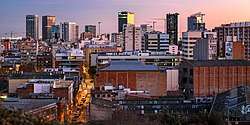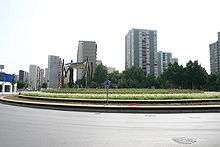L'Hospitalet de Llobregat
L'Hospitalet de Llobregat (Catalan pronunciation: [luspitəˈlɛd də ʎuβɾəˈɣat; ˌlɔs-]; Spanish: Hospitalet de Llobregat), often shortened to L'Hospitalet or just L'H, is a municipality of Spain, located to the immediate southwest of Barcelona, in the autonomous community of Catalonia.
L'Hospitalet de Llobregat | |
|---|---|
 | |
 Flag  Coat of arms | |
 L'Hospitalet de Llobregat Location in Catalonia  L'Hospitalet de Llobregat L'Hospitalet de Llobregat (Spain) | |
| Coordinates: 41°21′35″N 2°6′00″E | |
| Country | Spain |
| Autonomous community | Catalonia |
| Province | Barcelona |
| Comarca | Barcelonès |
| Founded | 12th century |
| Government | |
| • Type | Ayuntamiento |
| • Body | Ajuntament de L'Hospitalet |
| • Mayor | Núria Marín (2008)[1] (PSC) |
| Area | |
| • City | 12.4 km2 (4.8 sq mi) |
| Elevation (AMSL) | 8 m (26 ft) |
| Population (2018)[3] | |
| • City | 261,068 |
| • Density | 21,000/km2 (55,000/sq mi) |
| Demonyms | hospitalenc, -ca (ca) hospitalense (es) |
| Time zone | UTC+1 (CET) |
| • Summer (DST) | UTC+2 (CEST) |
| Postal code | 0890x |
| Dialing code | +34 (E) 93 (B) |
| INE code | 08 1017 |
| City budget (2014) | €200 million |
| Main festitivity | ? |
| Patron saint | Saint Eulalia |
| Website | l-h |
By population, it is the second largest in Catalonia and the sixteenth in Spain. It is one of the most densely populated cities in the European Union.
History and toponymy
The first records of the settlement date to the Neolithic era with artefacts showing human habitation in the Llobregat river area. Roman artefacts have been found dating to the 2nd century BC such as a funeral decoration representing the head of Medusa, now in the Archaeological Museum of Catalonia. However it is not until the 10th century that written references to Provençana (the city's original name) appear. The current name originates from the Catalan language and derives from a hostel next to the Church of Saint Eulalia of Provençana (Santa Eulàlia de Provençana) used by pilgrims in the Middle Ages. The city retained the character of a village until the 19th century when the first textile factories were built causing a population boom. The 1960s and 1970s saw a second population boom, caused by immigration from poorer regions of Spain: however this was not matched by construction of the necessary amenities and it was only in the 1990s that public investment resulted in additional schools, leisure facilities and housing.
The Swedish painter and former anarchist Ivan Aguéli died there, being killed by a train, in 1917.
Demographics
| 1900 | 1930 | 1950 | 1970 | 1986 | 2006 |
|---|---|---|---|---|---|
| 4948 | 37,650 | 71,580 | 241,978 | 279,779 | 261,310 |
A slight majority of the city's residential population is native to Catalonia and over 22% of the city's inhabitants were born outside Spain, (mainly in Ecuador, the Dominican Republic and Morocco). However the city has a large number of permanent or non-permanent residents from other countries of the European Union. Its population in the 2006 census consisted of 78% born in Spain (52% in Catalonia) and broke down as follows:
| Area | Population |
|---|---|
| Spain | 207,930 |
| The Americas | 35,628 |
| Africa | 7,935 |
| Asia | 5,375 |
| Europe (non-EU) | 2,428 |
| European Union | 2,004 |
| Oceania | 10 |
| Total | 261,310 |
Geography
L'Hospitalet's surface is 12.49 km2 (4.82 sq mi). The area on which the city is constructed may be divided in two different geological areas. One of them follows the coast typology and is called La Marina, similarly to two coast areas of neighbouring Barcelona's Zona Franca: La Marina del Prat Vermell and La Marina de Port. The latter half of L'Hospitalet is called El Samontà, which consists of hills and a more elevated area.
Economy
The city's reputation is largely still that of a depressed suburb,[4] drawing on its proletarian origins and its reliance on Barcelona. But its economy has improved recently, as can be seen from the city's new skyline and relocation of companies to the city's new financial centre. Urban regeneration and construction took place during the 2000s, as well as ongoing work on improving public transportation in the second municipality of the Barcelona metropolitan area. The former airline Spanair's headquarters were in L'Hospitalet.[5][6] Former mayor Celestino Corbacho has campaigned to improve the city's infrastructure from his position in the Ministry of Work.
Skyscrapers
- Torre Realia BCN (2009) – 119 meters – Completed
- Hotel Porta Fira (2010) – 118 meters – Completed
- Hotel Catalonia Plaza Europa (2011) – 105 meters – Completed
- Hesperia Tower (2006) – 106 meters – Completed
- Tower Caixa Catalunya (?) – 106 meters – Planned
- Torre Inbisa (2010) – 104 meters – Completed
- Torre Zenit (2009) – 104 meters – Completed
- Hospital de Bellvitge (1972) – 82 meters – Completed
- Tower Colonial (?) – 75 meters – Under Construction (on hold)
- Tower Fadesa I (2009) – 65 meters – Completed
- Tower Fadesa II (2009) – 65 meters – Completed
- Tower Fadesa III (2009) – 65 meters – Completed
- City Judicial Building A (2008) – 62 meters – Completed
- City Judicial Building C (2008) – 58 meters- Completed
- Torre Melina (Hotel Rey Juan Carlos) (1992) – 60 meters -Completed
- Hospital de Bellvitge
 Hesperia Tower
Hesperia Tower- Toyo Ito Towers
Administrative units
District I
- El Centre

El Centre is the historical centre of the city, the oldest neighbourhood, where the City Council is, as well as the centre of activities such as La Farga and many of the cultural buildings, such as the History Museum, the Can Sumarro library, the cultural centre Barradas or the Sala Alexandre Cirici. It borders the district of Sanfeliu and Can Serra to the north, Bellvitge to the south, Sant Josep to the east, and the city of Cornellà de Llobregat to the west.
- Sant Josep
Sant Josep remains framed by the square that is formed by the avenue of the Fabregada and that of Isabella The Catholic (Isabel la Catòlica) to the west, the Torrent Gornal to the east, the railroad on the north side Carrilet to the south. In this area, all the industrial activities that Hospitalet had through the ages left their mark: from the flour mills and the distilleries, up to the different energetic exploitation of the waterfalls of the Canal de la Infanta or the ceramic, textile, metallurgical and chemical industries. In fact, Sant Josep was originally an industrial suburb, but the subsequent disappearance of many factories, as well as the population increase, have given it a residential character.
- Sanfeliu
Civic life in this quarter centres on the avenue of the Cirerers and the Communities Square (Plaça de les Comunitats). This public space is the scene of the greatest holiday celebrations, such as the festival of Sant Joan, the Carnival, and many other popular events. The cultural centre is also at the heart of many of the activities.
District II
- Collblanc
This ward has a marked commercial character, centred near the Collblanc Metro stop. The Market Square (Plaça del Mercat) and the surroundings are the main centre of cultural life.
- La Torrassa
Its origins has been linked to Collblanc. Today, the Spanish Square (Plaça Espanyola) and the new park of La Torrassa are the at heart of this neighbourhood and is where the holiday celebrations at the beginning of every summer are largest.
District III
- Santa Eulàlia

Its origins are dated back to Medieval times thanks to the presence of the Santa Eulàlia de Provençana hermitage (dated in the 12th century thanks to an inscription in the façade). Also it was very important during the Industrial Revolution thanks to the presence of many industries in the quarter, such as Can Trinxet, L'Aprestadora or Can Pareto.
- Gran Via Sud
It is the smallest quarter in the town.
District IV
- La Florida
- Les Planes
District V
- Pubilla Casas
- Can Serra
District VI
.jpg)
- Bellvitge
In 1964 the Inmobiliaria Ciudad Condal S.A. (ICC) company initiated the construction of this neighbourhood as it stands nowadays, beside the hermitage, on land which had been bought from local farmers. It was designed as a residential area to house the large number of immigrants who came to Catalonia from elsewhere in Spain – more than 126,000 people in 1964 – in search of work.
District VII
Transport
International relations
Twin towns and sister cities
L'Hospitalet is twinned with the following cities:
See also
- Metropolitan area of Barcelona
- Zona Franca (Barcelona)
Notes
References
- "Ajuntament de l'Hospitalet de Llobregat". Generalitat of Catalonia. Retrieved 13 November 2015.
- "El municipi en xifres: L'Hospitalet de Llobregat". Statistical Institute of Catalonia. Retrieved 23 November 2015.
- Municipal Register of Spain 2018. National Statistics Institute.
- Lonely Planet Barcelona, p8, Damien Simonis
- L'Hospitalet de Llobregat (in Spanish), www.urbanity.es
- "Contacts." Spanair. Retrieved on 29 December 2009.
- "National Commission for Decentralized Cooperation". Délégation pour l'Action Extérieure des Collectivités Territoriales (Ministère des Affaires étrangères) (in French). Archived from the original on 8 October 2013. Retrieved 26 December 2013.
External links
| Wikimedia Commons has media related to L'Hospitalet de Llobregat. |
.svg.png)